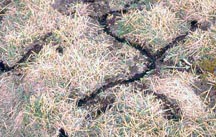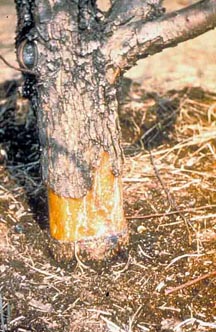Vole Damage Prevalent | |
|---|---|
| April 11, 2007 | |
|
With the heavy snowfall that remained for several weeks this past winter, many turf areas in northern and central Illinois are experiencing severe vole damage this spring. Vole damage appears as 2-inch-wide, winding, open runways through the turf. Occasionally, there is a burrow into the soil. Many young trees and shrubs have also been girdled.  Voles are native mice. Although several species occur in Illinois, all are brownish to black, with blunt faces and short tails. Their bodies are 4 to 5-1/2 inches long not, counting the 1- to 2-inch tails. They eat seeds and plants, including the roots, stems, and leaves of turfgrasses. They also feed on the shoots and bark of trees and shrubs, as well as flower bulbs.  Voles are fed upon by many predators, including dogs, cats, coyotes, mink, weasels, skunks, opossums, raccoons, snakes, hawks, and owls. As a result, voles are very secretive mammals, hiding in the soil or mulch under groundcovers most of the time. When deep snow remains for several weeks, voles are able to move and feed under the snow without fear of predation. This results in severe damage to turf, trees, and shrubs. Shrews are commonly blamed for vole runways, as they are frequently seen in them. In reality, these short-tailed, pointed-faced, mammals with 2- to 4-inch bodies are very predatory. A shrew in a vole runway probably killed and ate the vole. Damaged turf quickly heals as the grass plants on either side of the runways grow over them. This process can be hastened with overseeding. Damaged shrubs typically grow back from the roots; severely damaged trees are usually killed. Damage is difficult to avoid on turf during heavy snowfalls. Avoiding large areas of thick groundcover and keeping turf mowed regularly keeps the vole numbers low by keeping down their cover from predators. Young trees and shrubs can be protected with wire screening in the fall around the trunk of small trees or completely covering very small shrubs. Do not mulch more than 1 to 3 inches deep, and pull most of that away from the base of young trees and shrubs in the fall. After heavy snowfalls, shovel the snow away from the base of young trees. Both the mulch and snow removal exposes the voles to their natural enemies, reducing the likelihood of damage. Although these mammals are susceptible to labeled mouse poisons, it is generally best to avoid using them in landscapes. House mouse snap traps are too small to effectively trap voles. If baits or traps are used, they need to be placed into the vole burrows or into bait boxes in the runways. Otherwise, it is likely that birds or pets will get into them. | |
| Author: | Phil Nixon |
